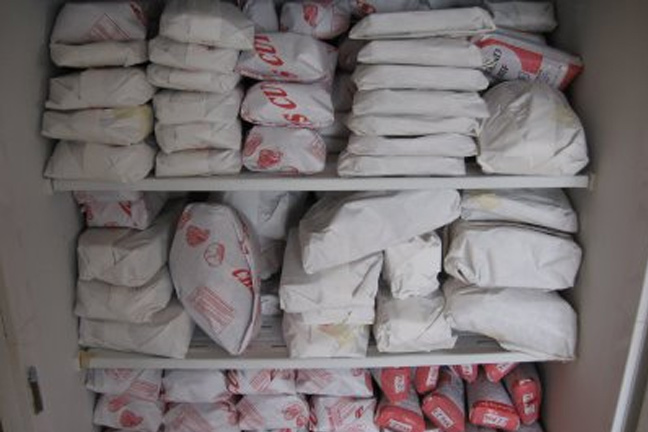
Agricultural News
Dr. Derrell Peel Separates the Myths and Realities of Cold Storage Beef and Its Market Impact
Mon, 28 Nov 2016 12:02:15 CST
 Mondays, Dr. Derrell Peel, Oklahoma State University Extension Livestock Marketing Specialist, offers his economic analysis of the beef cattle industry. This analysis is a part of the weekly series known as the "Cow Calf Corner" published electronically by Dr. Peel and Dr. Glenn Selk. Today, Dr. Peel calms the waters regarding rising concerns over the confusion of beef supplies held in cold storage and how this effects markets.
Mondays, Dr. Derrell Peel, Oklahoma State University Extension Livestock Marketing Specialist, offers his economic analysis of the beef cattle industry. This analysis is a part of the weekly series known as the "Cow Calf Corner" published electronically by Dr. Peel and Dr. Glenn Selk. Today, Dr. Peel calms the waters regarding rising concerns over the confusion of beef supplies held in cold storage and how this effects markets.
"Considerable ado has been made about large beef cold storage totals for the past year. This has resulted in questions, concerns and confusion among cattle producers and others about the implications of large cold storage holdings. I have gotten numerous questions about 'huge supplies of beef in cold storage that would keep beef markets depressed.' Misunderstanding has been increased by misleading media stories about cold storage. One such recent article by a major news service was entitled 'U.S. Beef Supplies at Highest in Records Dating Back a Century.' The article was referring to the reported October beef cold storage total of 532 million pounds, the largest monthly total since records began in December 1915. However, beef cold storage, which is frozen beef supplies maintained in commercial warehouses for more than 30 days, represents roughly two percent of annual beef production. In other words, 98 percent of beef is marketed as chilled fresh beef and does not pass through cold storage. Record cold storage inventories do not imply record beef supplies. Indeed, beef supplies, as measured by total annual beef production, exceeded the projected 2016 beef production total in 17 of the past 21 years.
"October cold storage represented 2.15 percent of annual beef production (a rolling twelve month total of beef production), fractionally less than the 2.16 percent from one year ago and less than the record monthly level of 2.19 percent in January, 2016. Cold storage inventories typically increase seasonally in the winter and decrease into the middle of the year. Since beef in cold storage is typically held for six to twelve months, a twelve month average of monthly cold storage inventories provides a good measure of cold storage management over time. The twelve month average of cold storage inventories for October was 1.97 percent of annual beef production compared to 2.01 percent at the same time last year. Since 2012, the monthly cold storage pipeline has averaged 1.82 percent of annual beef production and has ranged from 1.61 percent (October and November, 2014) to 2.07 percent (January, 2016). Therefore, cold storage inventories, or more correctly, changes in cold storage inventories from month to month are too small to be a direct beef supply issue except possibly in a few specific markets.
"While cold storage is only a minor component of total beef supplies, cold storage behavior is indicative of market conditions and challenges. Cold storage inventories include an unspecified mix of boneless beef trimmings and muscle cuts along with bone-in beef cuts. Bone-in beef cuts in cold storage have generally declined over time and represented 7.2 percent of October total cold storage inventories; the lowest proportion in over 20 years. The bulk of cold storage inventories are boneless product and are believed to consist mostly of trimmings and end meats. Rarely, and only under exceptional circumstances, significant quantities of middle meats may be put into cold storage. These frozen high quality steaks do not enter normal chilled meat markets when marketed and are typically sold at a discount. Trimmings and end meats are more commonly frozen though maintaining frozen stocks is expensive and is not done without a good economic reason.
"Holding beef in cold storage is motivated primarily by two separate but related market activities: the ground beef market and international beef trade. Changing flows of beef imports and exports may contribute to variation in cold storage inventories. For example, the build-up of cold storage in late 2015 was undoubtedly related to the dramatic increase in beef imports last year, most of which was frozen processing beef and was pulled out of cold storage over several months. Beef destined for frozen exports may contribute to increased cold storage inventories when exports are growing. Increased fed slaughter in 2016 has produced more fed trimmings and lean beef supplies are larger due to additional cow slaughter. Sharply growing beef production and a relatively weak ground beef market in 2016 likely account for the build-up to record cold storage supplies in October. Despite being only a small part of the overall beef supply, large current cold storage inventories of beef certainly reflect the marketing challenges that accompany growing beef production in 2016."
WebReadyTM Powered by WireReady® NSI
Top Agricultural News
More Headlines...




